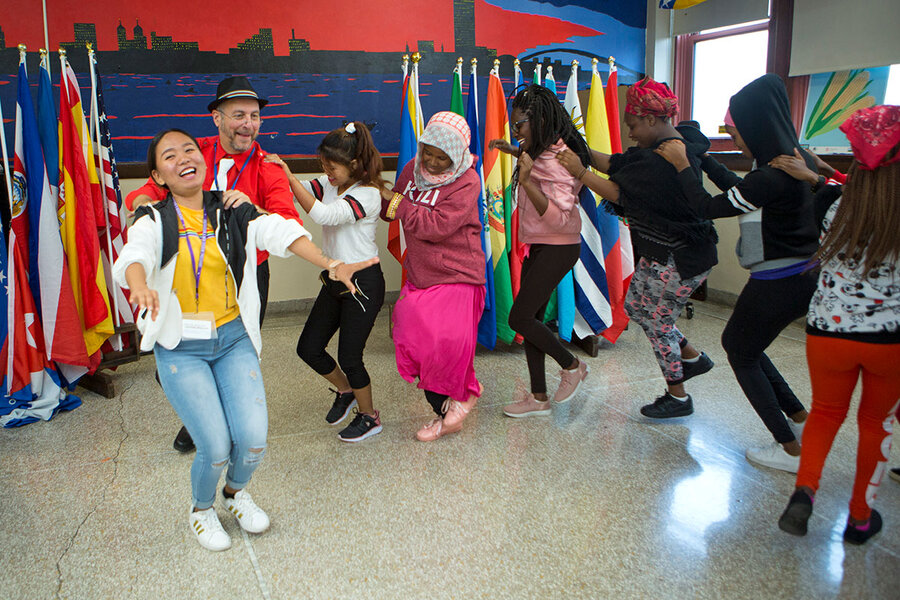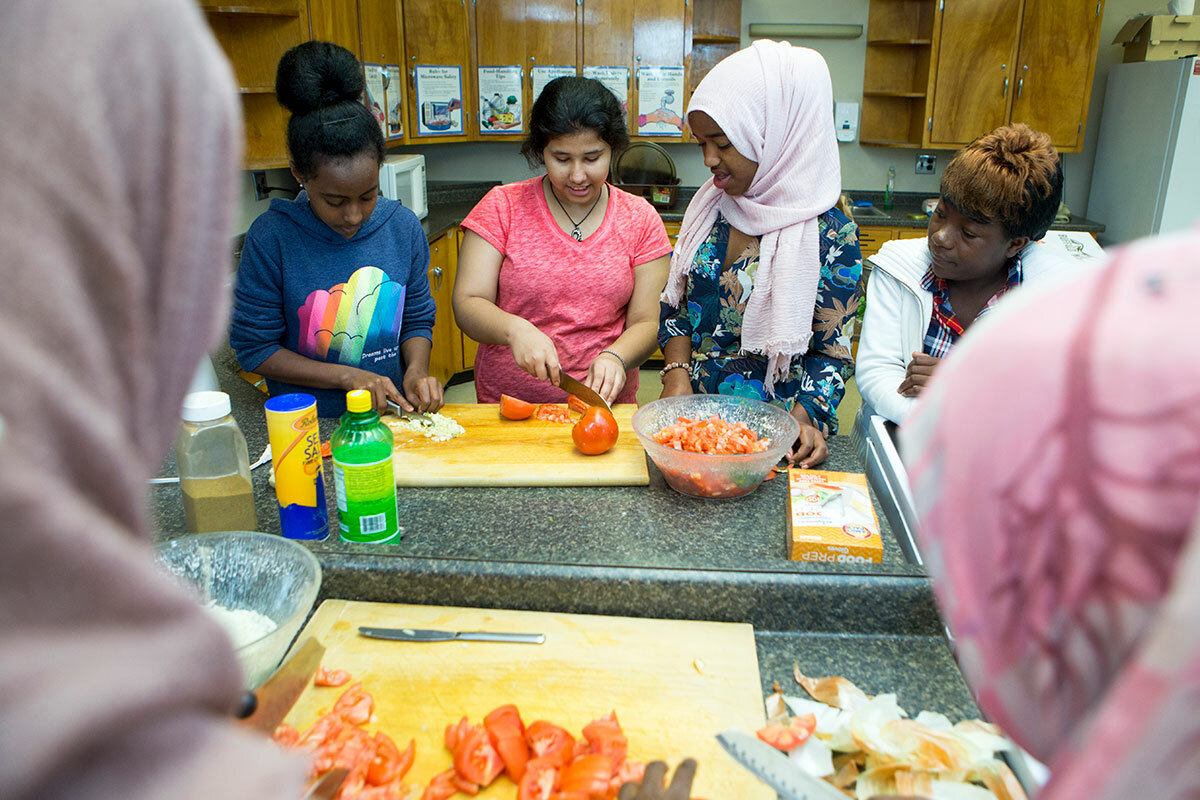Beyond test scores: How well do cities love their children?
Loading...
| Buffalo, N.Y.
Is it possible to measure how much a city loves its children? That’s the idea behind the Loving Cities Index from the Schott Foundation for Public Education. It is not meant to be a “gotcha” exercise, but rather a call to action – a way to highlight what’s working and what’s not en route to student success. The foundation came up with the idea after hearing grass-roots groups of parents and young people say that it didn’t seem like elected officials were showing the same kind of love to children in poor communities of color as they would to their own children. The resulting index has indicators in four categories – care, stability, commitment, and capacity. They range from health and housing policies to school-discipline practices and the availability of advanced coursework. “It’s a little bit tricky in an education-justice movement to not just be against things, and Loving Cities reflects something that we can be for,” says Allison Brown, who manages the initiative, which launched last year. At a time when federal institutions are often pitted against each other, local communities should envision a system, she says, “that provides love and support for all kids.”
Why We Wrote This
For students to succeed, they often need help with more than just academics. A new tool measures many ways cities can support equitable education, and encourages collective effort.
Salsa music heats up the basement cafeteria at Lafayette International Community High School on a chilly weekend morning. Students from Africa, Asia, and Latin America dance together in a circle, while kids and grandparents chat and eat. Twice a month, thousands of people gather in various neighborhood schools for Saturday academies – part of Buffalo’s community-wide partnership to show care for students and families who need everything from nutritious food to health services.
Upstairs, a volunteer teaches English to a mother from Somalia, and girls wearing hijabs and long skirts dice garlic to make pico de gallo during a cooking class. The sounds, smells, and smiles all add up to an atmosphere of love.
But is it possible to measure how much a city loves its children?
Why We Wrote This
For students to succeed, they often need help with more than just academics. A new tool measures many ways cities can support equitable education, and encourages collective effort.
That’s what the Schott Foundation for Public Education is aiming for with its Loving Cities Index.
For decades, schools have been measured mainly by test scores and other standard outcomes. But that approach, the foundation argues, has largely neglected the inputs needed – both inside and outside of school – to give children equal opportunities to succeed.
So it came up with 24 indicators that require collective effort. They range from health and housing policies to school-discipline practices and the availability of advanced coursework.
The foundation pursued the idea after hearing grass-roots groups of parents and students say that it didn’t seem like elected officials were showing the same kind of love to children in poor communities of color as they would to their own children.
“It’s a little bit tricky in an education-justice movement to not just be against things, and Loving Cities reflects something that we can be for,” says Allison Brown, who manages the initiative as a consultant to the Quincy, Mass.-based Schott Foundation. At a time when federal institutions are often pitted against each other, local communities should envision a system “that provides love and support for all kids.”
Buffalo, N.Y., is halfway there according to the index, first published in 2018.
Minneapolis, and Long Beach, Calif., join Buffalo in the “bronze” category. No city has yet scored high enough to earn silver, gold, or platinum.
The remaining cities measured so far – Baltimore; Chicago; Denver; Philadelphia; Charlotte, N.C.; Little Rock, Ark.; and Springfield, Mass. – are “copper,” at least a third of the way to the goal.
'A sense of community and hope'
The Loving Cities Index is not meant to be a “gotcha” comparison, but rather a call to action – a way to highlight what’s working and what’s not. Its indicators are in four categories: care (promoting health); stability (ensuring a safe living environment, transportation, etc.); commitment (developing a student’s potential, avoiding pitfalls such as unfair suspensions); and capacity (resources, teacher quality, curriculum).
The report offers up ideas about how cities can do better by kids, and awards some points based on how well they are narrowing gaps among racial and economic groups.
In the “care” category, access to mental health services for low-income children in Buffalo has improved significantly, for example, because of a partnership of the school district, the Community Foundation for Greater Buffalo, and the nonprofit Say Yes to Education, which supports high school and college success.
There’s “a sense of community and hope that people are seeing,” says David Rust, executive director of the nonprofit’s Buffalo chapter. It’s not easy to break out of silos, he says, but “the nice thing about collective-impact models … is [that] progress isn’t reliant on one individual.... It’s people holding hands and working together.”
Mental health is especially important to address at Lafayette, where many students arrive as refugees. “When we are interviewing teachers, I tell them, ‘You have to be a teacher of language … but you also have to [be like] a social worker,’ ” says Principal John Starkey.
Buffalo, Chicago, and Baltimore all need to improve their level of preschool suspension, which largely affects black children, the Loving Cities report notes. Buffalo’s superintendent has begun to address school discipline disparities and has launched anti-bias training.
Rethinking accountability
There has long been debate between standards-based reformers pushing for more accountability to close achievement gaps and critics who emphasize the context of poverty and other opportunity gaps. But to some degree that debate offers a false choice, since “both sides are right,” says Thomas Toch, director of FutureEd, a think tank at Georgetown University’s McCourt School of Public Policy.
The Loving Cities Index – which the foundation hopes to expand to 50 cities over five years – does give weight to strong academic expectations, even while advocating for broader policy changes to address poverty. Long Beach, for instance, earned low points for how few of its high school students (26 percent) enroll in at least one Advanced Placement or International Baccalaureate course.
The framework is encouraging and could be a catalyst, Mr. Toch says, for “bringing together the commitment to academic rigor and an expanded focus on the non-schooling challenges that students face.”
The index is beginning to make its mark. Many in Buffalo are on board with the whole-child focus, and an advocacy group in Denver is planning a Loving Cities convening in March to work on an equity agenda, Ms. Brown says.
Other cities have said the language resonates, she adds. “It’s very complicated to start talking about intersectionality – poverty and health and housing and schools.... But having a language like ‘Loving Cities’ gives a framework … and makes it more tangible.”









